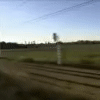|
B4Ctom1 posted:
The sad thing is, this is not at all far-fetched in this industry...at all.
|
|
|
|

|
| # ? May 14, 2024 00:27 |
|
I totally get that "the point" of railroad sim videogames is to avoid derailments, but the sociopath in me who plays Grand Theft Auto games so he can cause wanton destruction wishes there were railway sims with "realistic" (or at least "cinematic") physics when you derail a train. Stuff like having cars going tumbling and snapping trees like toothpicks, actual damage to engines/cars, explosions and fire, all that poo poo.  If I send two freight trains head-on at eachother at 60mph apiece, I want the end result to be completely ridiculous. If I send two freight trains head-on at eachother at 60mph apiece, I want the end result to be completely ridiculous.
|
|
|
|
Xenomrph posted:I totally get that "the point" of railroad sim videogames is to avoid derailments, but the sociopath in me who plays Grand Theft Auto games so he can cause wanton destruction wishes there were railway sims with "realistic" (or at least "cinematic") physics when you derail a train. Stuff like having cars going tumbling and snapping trees like toothpicks, actual damage to engines/cars, explosions and fire, all that poo poo. This, but with post-accident inquiries written by B4Ctom1
|
|
|
|
The first "train sim" game was called TrainMaster, which for most of its existence was mostly just a train physics simulator. It included a decent-looking (for the era - early 1990s) control stand for the user to use, but the GUI showing the train was a primitive side-scrolling view of the train rolling through the landscape on par with MS paint. The final versions of TrainMaster (published around 2000 or so) did finally come with a decent out-the-cab view in the GUI, but didn't have all the external camera angles to view the train with, and you couldn't switch tracks/uncouple cars like you could in the original Microsoft train simulator. TrainMaster did have good sound though - good, bass-ey recordings of an EMD 645 prime mover. One thing TrainMaster didn't do was show you your train wrecking when it left the rails. In fact, the whole simulation was only based on the physics of a dead load equivalent to the weight of a train, and there was no slack action to deal with. If you did "wreck," I think the screen faded to black, and then you'd see an animation of your "engineer's license" being torn in half.
|
|
|
|
Xenomrph posted:I totally get that "the point" of railroad sim videogames is to avoid derailments, but the sociopath in me who plays Grand Theft Auto games so he can cause wanton destruction wishes there were railway sims with "realistic" (or at least "cinematic") physics when you derail a train. Stuff like having cars going tumbling and snapping trees like toothpicks, actual damage to engines/cars, explosions and fire, all that poo poo. "Burnout: Loco Edition"
|
|
|
|
Xenomrph posted:I totally get that "the point" of railroad sim videogames is to avoid derailments, but the sociopath in me who plays Grand Theft Auto games so he can cause wanton destruction wishes there were railway sims with "realistic" (or at least "cinematic") physics when you derail a train. Stuff like having cars going tumbling and snapping trees like toothpicks, actual damage to engines/cars, explosions and fire, all that poo poo. Train sims can do 'completely ridiculous' quite well. https://www.youtube.com/watch?v=06rabZDYDlU https://www.youtube.com/watch?v=rulElJITIVY
|
|
|
|
Do I need to put up scans of my Densha De D manga again?
|
|
|
|
9axle posted:The brakes don't apply on the entire train all at once, there can be a significant delay between the front and rear. When the front slows significantly, and the rear is still moving at track speed, things can get exciting. The force can be enough to force the midle right off the tracks. So the brakes work like a normal car and not like a semi? Or it does both....maybe? You'd think that they might like a rear lock-up first because if it breaks the train up, it's replacing couplers instead of "well, this is going to take a couple of weeks with a plasma to cut apart a ball of steel that was once a train" I loved that Calvin and Hobbes strip too, but you forgot the farmer lighting his stove at the same time.
|
|
|
|
InterceptorV8 posted:I loved that Calvin and Hobbes strip too, but you forgot the farmer lighting his stove at the same time. InitialDave fucked around with this message at 21:25 on Sep 6, 2012 |
|
|
|
InterceptorV8 posted:You'd think that they might like a rear lock-up first because if it breaks the train up, it's replacing couplers instead of "well, this is going to take a couple of weeks with a plasma to cut apart a ball of steel that was once a train" Somehow I don't think cars coming apart is a good idea, you might wind up with this calming scene.
|
|
|
|
B4Ctom1 posted:4004 is here in Cheyenne in a park. The streets buckled when they moved her to her final resting place I seem to recall being able to climb all over this during my childhood. Also that one time the entire park flooded with several feet of water (1997?), though it looks like it's been repainted since then. As a kid two of my favorite things were the Big Boy and the Big Bud which made my conversations really hard to follow.
|
|
|
|
Before I came to Australia, I used to do Voluntary work on a couple of preservation railways in the UK. (Keighly and Worth Valley Light Railway, and North Yorkshire Moors Railway). I soon learned why steam crews loved Diesels when I was on my first Tender-first run in Autumn rain! (I was a trainee fireman) Sadly I met a driver who had been in an accident with a kid from my old School - The Dickhead was walking across a viaduct, heard a train approaching (horn) saw a train approaching from one direction and stepped on to the opposite track, right in front of this guy's train, he applied full service emergency but hit the kid doing about 60mph, needless to say there wasn't much of him in any large recognisable pieces. Whilst you had to feel sorry for the kid's family, I felt more sorry for the driver; he removed himself from the 'top-link' roster and apparently suffered from PTSD for as long as I knew him. His way to relax was to return to steam on holidays. He claimed that having a cab in front was a curse, despite its creature comforts because he still relived his 'grand-stand' view of the kids face before he hit. He often told me of other drivers in the steam age with similar incidents; sure it affected them, but that huge firebox / boiler combination sitting in front served as 'insulator' from the true horror of the moment of impact. Breaking from topic, I was amazed at how well the fireman was looked after on most of the Aussie steam locos I've seen. The firebox door is nice and high and saves you from shovelling coal whilst bent into the shape of a swastika! Drop-Bear fucked around with this message at 02:47 on Sep 7, 2012 |
|
|
|
InterceptorV8 posted:So the brakes work like a normal car and not like a semi? Or it does both....maybe? Its kind of hard to describe with out seeing it but I will try to explain it best.... Scenario 1: Conventional train, engines on the front and cars on the rear. When there is a brake pipe reduction, the first car closest to the engine sets first, then the next car, then so on. Yes its very quick, but it does happen like that. Scenario 2: Distributed Power, also known as DPU. Brake pipe reduction happens from both ends. When the front engines set air, the rear engine also makes the same reduction, resulting in brakes setting from both ends towards the middle. IE car 1 and car 99 set air, then car 2 and car 98 set air and so on. Scenario 3: Mid Train DPU. Engines on the front, and engines in the middle of the train. Again, air sets 1st car, 50th car next to middle train engine and 51st car sets air. Then car 2 sets air, 49th car sets air and 52nd car sets air. That is the basic set up of most trains, and does takes a little skill on how you plan to make a stop. As silly as this sounds, I run the train with my butt. Yes, you can actually feel how a train is reacting with how it feels. I think bt4com can attest to this, but after a while, you develop a feel for what is going on behind the engines. It takes time, and a little patience. I learned it from the old guys, and when I train a new guy, I tell them the same. Run it from your rear end and not from what the book tells you. Because college degree does not mean the same as time in the chair 
|
|
|
|
BrokenKnucklez posted:Scenario 2: Distributed Power, also known as DPU. Brake pipe reduction happens from both ends. When the front engines set air, the rear engine also makes the same reduction, resulting in brakes setting from both ends towards the middle. IE car 1 and car 99 set air, then car 2 and car 98 set air and so on. Just curious - what's the reason behind this setup? I spent a week in Wisconsin at the start of last month for a family reunion and a BNSF north/south line runs right through my grandmother's family's property along the Mississippi (so we end up watching a lot of trains go by.) About every third train had an engine on the rear, the best explanation we could come up with was so they could change direction without having to move the engines around.
|
|
|
|
Geoj posted:Just curious - what's the reason behind this setup? I spent a week in Wisconsin at the start of last month for a family reunion and a BNSF north/south line runs right through my grandmother's family's property along the Mississippi (so we end up watching a lot of trains go by.) About every third train had an engine on the rear, the best explanation we could come up with was so they could change direction without having to move the engines around. Nope. Fuel savings. 3 units on a conventional train actually burn more fuel than 2 on the head end and 1 on the rear. I do not know the exact science behind all of it, but it does burn less fuel. I imagine some one else has the exact reason behind all of it. All I know is it makes running a heavy coal train easier.
|
|
|
|
BrokenKnucklez posted:Scenario 1: Conventional train, engines on the front and cars on the rear. When there is a brake pipe reduction, the first car closest to the engine sets first, then the next car, then so on. Yes its very quick, but it does happen like that. On the side of Amtrak Superliner coaches, there are yellow lights which illuminate once the automatic brake is applied. I don't know what the threshold is on how much pressure triggers it, but if you stand and watch a Superliner consist pull into a station from a good speed to a dead stop, you'll see these lights come on, first on the cars up front by the engine, and then back to the end of the train. Of course since it's a passenger train and short, it doesn't take longer than 3-4 seconds for all the lights to light up so you really have to watch for it, but you do see it.
|
|
|
|
Re: advantages of distributed power I heard it was to reduce the strain on the couplers, especially on heavy trains that need to climb steep grades. If the locomotives are just at the front of the train, the couplers on the first car have to be strong enough to drag all the cars up the steepest grade they encounter. By putting a locomotive in the middle or at the end, it's now pushing some of the cars and each locomotive is pulling fewer cars, basically two short trains coupled together.
|
|
|
|
InterceptorV8 posted:So the brakes work like a normal car and not like a semi? Or it does both....maybe? Kind of like a truck. There is a single air pipe, called the train line that runs the length of the train and supplies air to the cars. On each car there is a pressure sensing valve and 2 reservoirs(actually a single tank split in the middle). The engineer reduces the brake pipe pressure to apply the brakes. The valve senses this reduction, and lets air flow form one of the reservoirs to the brake chamber to apply the brakes. If the brake pipe pressure is reduced to far, the valve triggers an emergency application, where all the air in the other reservoir(maybe both, i'm not sure) is immediately dumped into the brake chamber, applying the brakes as hard as they can be applied. Now the brakes on every car are locked, held on with air pressure(no springs, like a truck) and the reservoirs are empty. Now you have to recharge the train line and reservoirs, but the cars near the engine fill first, and the brakes on those cars release. On a steep hill, this can be bad, as it can cause a slack effect that can be enough to get the train rolling again, only now with nowhere near the braking power it had. And maybe in the wrong direction. The conductor usually applies a ton of hand brakes when the train goes into emergency before the engineer resets the system and pumps air back into the line however, to prevent this from happening.
|
|
|
|
Wouldn't it be fairly simple to have a program account for the time delay in braking and have all the brakes be applied at the exact same time?
|
|
|
|
Dick Diggler posted:Wouldn't it be fairly simple to have a program account for the time delay in braking and have all the brakes be applied at the exact same time? You'd have to control the brakes on a car-by-car basis instead of the whole train at once. It could be done, but you'd need to have every car you ever plan to run on your train set up for it. You could probably get close to the functionality just by being able to brake in segments, but if you're going to automate that much why not automate the whole train?
|
|
|
|
Dick Diggler posted:Wouldn't it be fairly simple to have a program account for the time delay in braking and have all the brakes be applied at the exact same time? I've heard before that the railroad is like an operating museum, the brake technology you see out there working now was invented almost 150 years ago. I've been with the railroad 9 months and it's been very evident to me that nothing changes quickly out here, if at all.
|
|
|
|
NoWake posted:I've heard before that the railroad is like an operating museum, the brake technology you see out there working now was invented almost 150 years ago. I've been with the railroad 9 months and it's been very evident to me that nothing changes quickly out here, if at all.
|
|
|
|
Expense, reliability, and resistance to change would be the main issues. One of the railroad employees here could explain it better than me but standardization is one of the most important things in the railroad industry, and standardizing across ~1.5 million freight cars is neither cheap nor easy. Any wireless (or wired) system which could stand up to the kind of abuse freight cars are subjected to without maintenance for long periods of time in all weather as well as being fairly tamper-proof would probably cost several thousand dollars. Add to that the work to install all of these systems, and the amount of time it would take before they'd even be useful (a large percentage install base) and you're talking tens of billions of dollars with no short term advantage to the companies footing the bill. None of these are insurmountable obstacles and automated remote braking systems are probably going to be mandated for installation on locomotives sometime in the next 10 years but I very much doubt a change this major would happen without a government mandate and government funding assistance.
|
|
|
|
Cocoa Crispies posted:Why change when what exists works? The annual costs of and losses from pneumatic brakes aren't as expensive as moving to something that may be better in the long run but hasn't been designed, built, and tested for a century. As far as the MoW side is concerned, it is the same thing, the new technology seems to work well on paper, but fails terribly out in the field. We had tried to use new insulator plates under i-bonds, thinking they would be great. Turns out they were big wastes of money and we are back to using old technology. The railroad in general really follows "if it ain't broke don't fix it." I am waiting to see how PTC works...
|
|
|
|
9axle posted:Now the brakes on every car are locked, held on with air pressure(no springs, like a truck) and the reservoirs are empty. Any particular reason why it works this way, rather than the truck-style springs? It would seem like the spring system is more fail-safe. Is it basically that one car is rarely on its own, so a single car's air pressure failing is basically irrelevant where a single car losing an air line could cause that brake to lock up while the engineer has no idea?
|
|
|
|
This is an industry that technology works against. Sure there was the change from steam to diesel... loss of the caboose... and a few other things, but very very little has changed. Even the concrete ties that MOW installed works great in the desert but in northern climates, they are absolute decimated. I have personally seen the UP throw away millions of dollars on trying to keep concrete ties working on the Overland route (LA-Chicago). But you can see piles upon piles of busted concrete ties next to the right of way in our territory. RCO's (remote control operations) are still ineffective. Sure it looks awesome on paper but it cuts down on efficiency. Sure they have their place on the RR, but rarely work. But in reality is, this is an industry that thrives on old fashion human interaction. PTC I feel will be a giant disaster.
|
|
|
|
BrokenKnucklez posted:Nope. Fuel savings. 3 units on a conventional train actually burn more fuel than 2 on the head end and 1 on the rear. I do not know the exact science behind all of it, but it does burn less fuel. I imagine some one else has the exact reason behind all of it. All I know is it makes running a heavy coal train easier. Can I just say that this is the most appropriate username/post topic combo.  Sorry for the text wall incoming... I would imagine the fuel savings come from running diesel locos at their most efficient throttle settings for the longest period of time, a bit like how in a car it is less efficient to take off quickly than use a gentle, gradual acceleration. Also typically anything greater than about 30 triple valves (recommended by the AAR from memory?) and the brakes can struggle to come on beyond that point, simply because there isn't a fast enough decrease in pressure to trip the brake valves into applying the brakes (the speed of decrease is needed to overcome static friction in the brake valve moving components). Even with the invention of inshot valve portions (contain a small 'burst' of air that is used to basically kick the brake rigging so that it doesn't stick due to friction) and reduction ensuring valves (I think that's what they're called. They basically take a gulp of air out of the brake pipe to better propagate the brake signal down the train), generally 30 triple valves is the rule of thumb. This is what happens when Distributed Power contributes to an accident: http://www.home.railscene.com/zanatta/blakmt01/blakmt01.html Dick Diggler posted:Wouldn't it be fairly simple to have a program account for the time delay in braking and have all the brakes be applied at the exact same time? ECP (Eletrically controlled pneumatic) brakes cover for this somewhat. Along with the brake pipe running down the train, you have an electrical cable (called a trainwire) running down the train as well. The brake pipe is there for two reasons. 1. To provide a redundancy to the electrical system if the train breaks apart, and 2. to recharge the brake reservoirs. 99.9% of the brake applications on ECP trains are controlled by the trainwire, which sends signals to computers on each car to apply and release brakes. The trainwire itself protects breakaways by having a device at the end (called, unimaginatively, an End of Train Device (EOTD). This monitors the train brake pipe and completes the trainwire circuit, and if either the circuit breaks or the brake pipe pressure drops too quickly, it throws the brakes on (this helps to keep the train stretched in an emergency as well because it applies the brakes from the back). So while you're still relying on an air brake system, the method by which brake commands are sent is electrical and failsafe (as well as being backed up by a "traditional" air brake system). wolrah posted:Any particular reason why it works this way, rather than the truck-style springs? It would seem like the spring system is more fail-safe. Generally up to about 10% of a train's brakes can be nonworking before you see a serious drop in brake performance. Stuck brakes do happen, and can cause derailments, but most of the time they'll cause a whole heap of sparks and track damage as the stuck wheels drag on the rail. Locked up wheelsets also occur due to failed bearing journals (fun times if this happens on one wheel, it basically corkscrews the axle and derails the train). Most of the time they're due to mechanical components (brake beam and guides) getting caught up rather than air failures. If the brake pipe fails, then all the brakes come on all carriages. If the internal air lines fail on a single carriage then it'll bleed air and the brakes will never come on. Without knowing 100% by springs aren't used, there are a few potential reasons I can think of: 1. You can bleed air off in a brake system and cut out brakes (basically bypassing the brakes on a car if they're faulty). Substantially more labour intensive if you're using springs (have to bar back the spring and lock it in place somehow). 2. Maintenance & reliability of air components is probably easier than having to maintain internal springs (having to pull apart the brake cylinder to check spring quality as opposed to doing a few air pressure tests) Also friction in mechanical/spring components could be higher.
|
|
|
|
BlackShadow posted:
Most yard switching is done with the brakes bled off, allowing cars to roll freely. Ina flat yard, the engine stops quickly as the pin is lifted on the car, "kicking" the car down the selected track. A good crew, with a brakeman working the switches,and a conductor who knows his job can switch a ton of cars really quickly this way. To prevent cars from rolling out the other end of the track, many yards are built with a bowl shaped contour. Part of the skill of a conductor is knowing this contour, and how hard to kick cars into a track to ensure they couple to cars already there, but not fire them out the other end. Spring brakes would make this process incredibly slow, as all it takes to bleed brakes off is a quick tug on the rod attached to the bleed valve on the current set-up. The guys who do this out here do it without ever getting out of their truck. Of course, over time, cars will also bleed themselves off, so hand brakes are used on any cars left standing.
|
|
|
|
9axle posted:Most yard switching is done with the brakes bled off, allowing cars to roll freely. Ina flat yard, the engine stops quickly as the pin is lifted on the car, "kicking" the car down the selected track. A good crew, with a brakeman working the switches,and a conductor who knows his job can switch a ton of cars really quickly this way. To prevent cars from rolling out the other end of the track, many yards are built with a bowl shaped contour. Part of the skill of a conductor is knowing this contour, and how hard to kick cars into a track to ensure they couple to cars already there, but not fire them out the other end.
|
|
|
|
9axle posted:Most yard switching is done with the brakes bled off, allowing cars to roll freely. Ina flat yard, the engine stops quickly as the pin is lifted on the car, "kicking" the car down the selected track. A good crew, with a brakeman working the switches,and a conductor who knows his job can switch a ton of cars really quickly this way. To prevent cars from rolling out the other end of the track, many yards are built with a bowl shaped contour. Part of the skill of a conductor is knowing this contour, and how hard to kick cars into a track to ensure they couple to cars already there, but not fire them out the other end. Oh yea, I completely forgot about that. Makes complete sense. I'm surprised my immature brain slipped on that, I still chuckle every time I see "Do Not Hump" on a train car.
|
|
|
|
BlackShadow posted:I would imagine the fuel savings come from running diesel locos at their most efficient throttle settings for the longest period of time, a bit like how in a car it is less efficient to take off quickly than use a gentle, gradual acceleration. It's also (as you learnt today  ) due to the fact that around corners, the geometry of two adjacent wagons under tension through their couplers creates a lateral thrust towards the centre of the curve, pushing the inside wheel flanges in to the rail and increasing friction. This is purely a function of the longitudinal tension in the consist. Putting a remote loco in the middle of the consist means that the tension forces are reduced due to: ) due to the fact that around corners, the geometry of two adjacent wagons under tension through their couplers creates a lateral thrust towards the centre of the curve, pushing the inside wheel flanges in to the rail and increasing friction. This is purely a function of the longitudinal tension in the consist. Putting a remote loco in the middle of the consist means that the tension forces are reduced due to: a) the middle loco pushing the front wagons (putting compression back in to that half), and b) reducing the overall tension on the rear half as there's only half as many wagons in pure tension behind the rear-most locomotive. Doing this reduces fuel consumption as there's less induced friction from corners which, as per a presentation Blackshadow and I saw today, can be of the order of ~25% of the total drag on a consist (including drag induced by grades, eg: going uphill - which is relevant because your tightest corners tend to be in the same place as your steepest grades through winding hills).
|
|
|
|
Any theories on how a derailment like this happens? 3 locomotives, no cars, in a yard(?). While naturally it's still under investigation, all the spokesperson says in all the news stories is "many things could have caused this". Such as...? Raw video (has sound & starts automatically, mind your speakers): http://www.wdbj7.com/videogallery/72205695/News/Trains-derail-in-downtown-Roanoke
|
|
|
|
JacquelineDempsey posted:Any theories on how a derailment like this happens? 3 locomotives, no cars, in a yard(?). While naturally it's still under investigation, all the spokesperson says in all the news stories is "many things could have caused this". Such as...? Locomotives do have enough throttle and brake force to roll or dislodge the rail. But, that actually looks like speeding to me. Most yard crossovers and switches are only 10 MPH and some are 5 MPH. Just because that is what I think happened doesn't mean that is what happened. For example, maybe someone else went over it too fast or too powerfully and dislodged it. or Maybe nobody has inspected let alone maintained that piece of track for years. No matter what, the result can be similar in each case.
|
|
|
|
B4Ctom1 posted:
Oh, I know, I was just looking for speculation.  I honestly had no clue as to what could make a 4 jillion ton loco just flop over at what I assumed was a pretty slow speed. I honestly had no clue as to what could make a 4 jillion ton loco just flop over at what I assumed was a pretty slow speed.I emailed the story to my father, who used to have an engineer license and ran short lines in upstate NY. His response: "Some trackbed inspector is going to get their rear end kicked for that one." JacquelineDempsey fucked around with this message at 14:07 on Sep 12, 2012 |
|
|
|
B4Ctom1 posted:Locomotives do have enough throttle and brake force to roll or dislodge the rail. We all know the correct answer. Blame the engineer, improper throttle modulation. Pee in a cup, get 30 days on the street.
|
|
|
|
JacquelineDempsey posted:"Some trackbed inspector is going to get their rear end kicked for that one." "I cannot blow the whistle and I cannot ring the bell, but if that fucker jumps the track, look who catches hell."
|
|
|
|
Lots of old footage of these beasties on a BBC Four documentary this evening. Built in the mid 70s, expected to be running until 2035
|
|
|
|
Gotta put things in perspective... they look like ancient poo poo to the Europeans, we Americans look at a future we never had 
|
|
|
|
I always find it cool when a train using an overhead catenary zooms by and a couple of sparks leap off the pantograph. There was a video I saw of one in Japan going full speed through a station at night and it looked like lightning had struck it because of how huge the spark was.
|
|
|
|

|
| # ? May 14, 2024 00:27 |
|
Mahmoud Ahmadinejad posted:Lots of old footage of these beasties on a BBC Four documentary this evening. Didn't know about that, thanks - will check the iPlayer. I studied in Derby and the St Pancras - Derby line was run by a mix of those Class 43s and whatever the new Pendolino trains that London Midland ran were, and the 43s were always much nicer to travel in because there was double the interior space per passenger. I don't know if they were slower but they were definitely a lot smoother. I lived about 1000yards from Derby station so I got to hear them pulling out the station a lot, and it is the most glorious, Thunderbirds-esque sound that I missed from my childhood - at home I've never been even so much as out of eyeshot of the West Coast mainline despite moving house 3 times, but they pulled the 43s off about 20 years ago? The Design Museum had a good retrospective on Ken Grange last year and of course, the 43 was a huge part of it:    Prototype chair for the HST:  Got a poster print of the 43 artwork framed, as well. They had planned to get in a 43 and repaint it in it's original Intercity livery, but it wouldn't quite clear the gallery doors. Real shame. In short: love the 43s. echoplex fucked around with this message at 09:29 on Sep 14, 2012 |
|
|




































